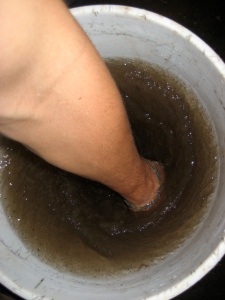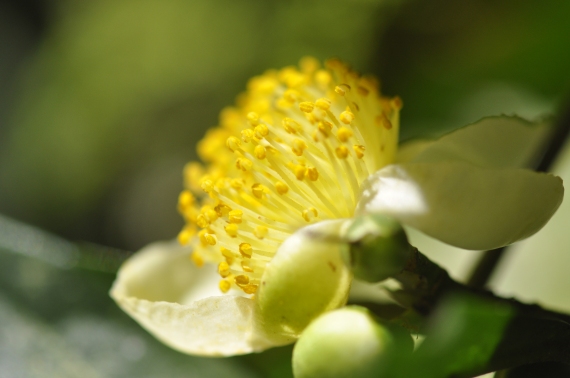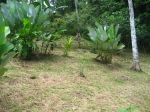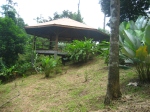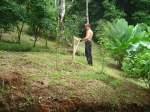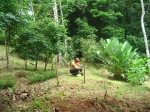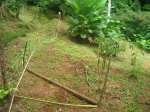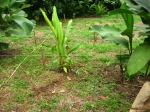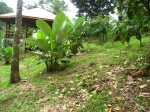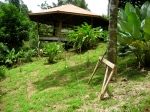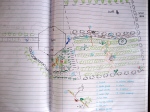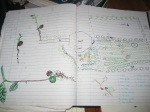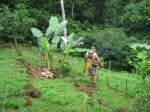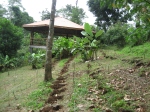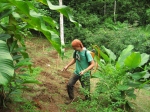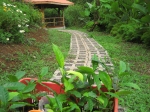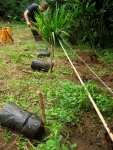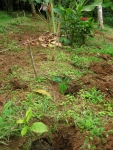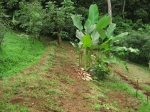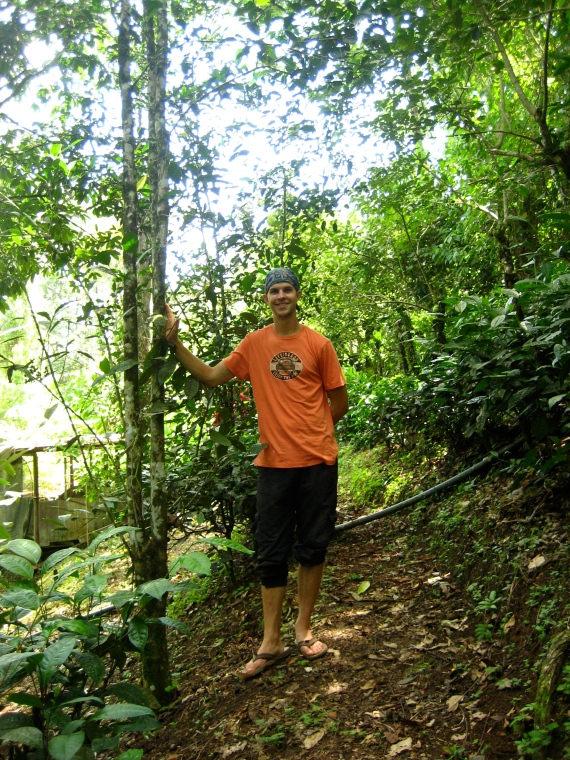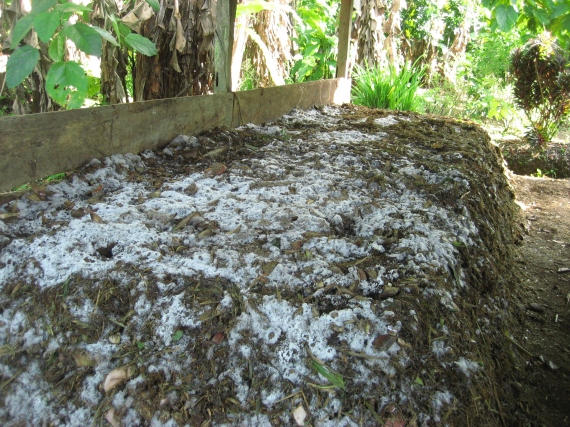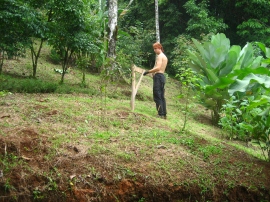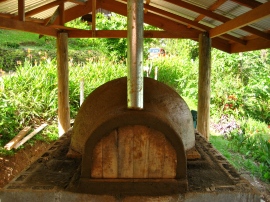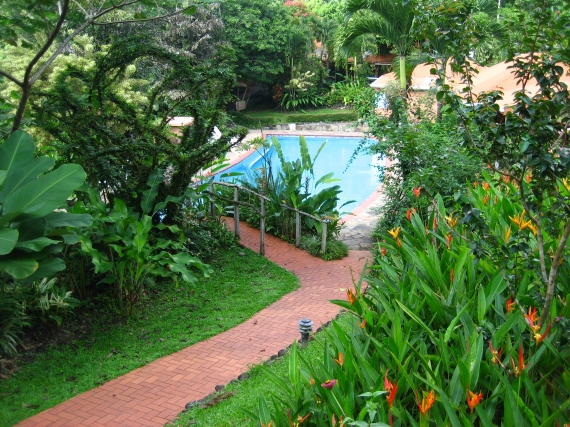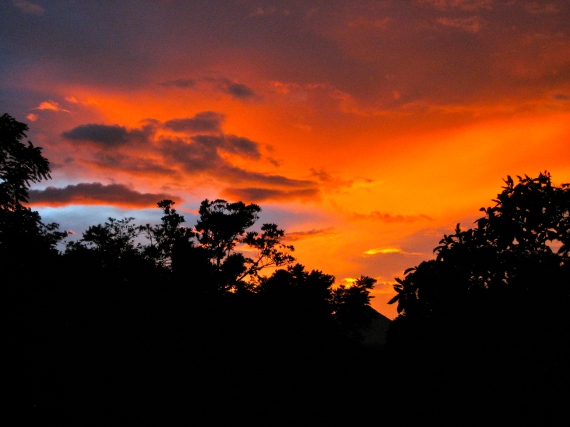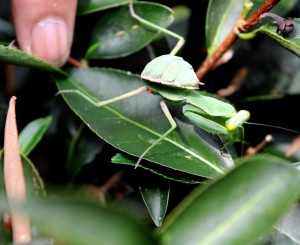Wow, it’s going to be tough to even start this entry. Why? because somehow I have to summarize this: the day we made tea – which took until 2am – in Rui-Li, a small tea town on the famous AliShan range.

Our day began with clarity in sky. At 11oo m above sea level, the mountain range view breaks free from the ubiquitous haze that surrounds the lower valleys.  Before any serious tea processing of our own, we first witnessed some nearby tea pluckers and introduced ourselves to the little angels in the tea garden: the green leaf hopper.
Before any serious tea processing of our own, we first witnessed some nearby tea pluckers and introduced ourselves to the little angels in the tea garden: the green leaf hopper.
In this small mountain tea village, we need not travel far to see row upon row of tea evergreen. It’s similar in experience to looking out over the ocean with no land in site, but where the horizon once met the waters’ edge, it now blurs with the undulating flow of flushing tea leaves.

– If you’ve never seen smiling tea plants before, now you have –
It was time to do something most of us had never done before: process tea – all day. We walked back to the Dong Ding Tea Garden factory where two bamboo trays of freshly harvested tea leaves awaited each of us. We were about to begin making our own High Mountain lightly oxidized Oolong tea from the Chin Sin cultivar.
 Meet Mr. and Mrs. Wang, the award-winning resident tea makers at Dong Ding Tea Garden. They’re young, open-minded, and hard-working enough to run this full-time factory while caring for their two children on a mountain range that requires 36+ complete switchbacks to drive up! Mr. Wang, at age 18, started to take over the factory for his father and now has 20 years experience as a farmer and tea processor. It’s interesting to note that most farmers don’t process their own tea, but rather pick it and sell it to a tea manufacturer for future processing. From the farm to your cup; making tea is more of a compartmentalized system of specialists; farmers, pickers, manufacturers, bakers, blenders, brokers, wholesalers, retailers, and finally, the consumer. This is the difference between a large-scale commodity like Taiwanese tea and the cottage industry of Hawaii-grown tea where farmers do everything themselves on a very small, manageable scale.
Meet Mr. and Mrs. Wang, the award-winning resident tea makers at Dong Ding Tea Garden. They’re young, open-minded, and hard-working enough to run this full-time factory while caring for their two children on a mountain range that requires 36+ complete switchbacks to drive up! Mr. Wang, at age 18, started to take over the factory for his father and now has 20 years experience as a farmer and tea processor. It’s interesting to note that most farmers don’t process their own tea, but rather pick it and sell it to a tea manufacturer for future processing. From the farm to your cup; making tea is more of a compartmentalized system of specialists; farmers, pickers, manufacturers, bakers, blenders, brokers, wholesalers, retailers, and finally, the consumer. This is the difference between a large-scale commodity like Taiwanese tea and the cottage industry of Hawaii-grown tea where farmers do everything themselves on a very small, manageable scale.
 Blessed by light sunny weather, we gathered our tea trays and set them out to wither, but not before Mr. and Mrs. Wang showed us their electronically controlled shade and rain protection. Based on the heat of the sun and the feel of the leaves (gauged by the tea master and on-site Scientist), we shuffled our trays of tea leaves back and forth from sun to slight shade.
Blessed by light sunny weather, we gathered our tea trays and set them out to wither, but not before Mr. and Mrs. Wang showed us their electronically controlled shade and rain protection. Based on the heat of the sun and the feel of the leaves (gauged by the tea master and on-site Scientist), we shuffled our trays of tea leaves back and forth from sun to slight shade.
Withering (and singing)
This process is known as (outdoor) withering. The leaves gradually lose moisture and start to wilt because of the heat. The leaves initially lose moisture through the pluck of the stem and also pores on the back and edges of the leaf. The leaves become more pliable, lose their luster, and take on a noticeable change in aroma. Even more subtle are changes that only the tea master is experientially aware of.



To coax the leaves as they wither in stillness, our fearless leader and Taiwan Tea Ambassador extraordinaire, Mr. Thomas Shu, sang a beautiful Taiwanese tea song. Thomas Shu writes songs for each Taiwanese tea. Not only does he have a great voice, but he sings with all the warmth of his heart. I’m not sure I’ve met anyone as passionate about Taiwan and Tea as this gentlemen among gentlemen – possibly only his wife, Josephine Pan can rival him in devotion to Taiwan and Tea! As well, Thomas carries on the traditional name of “Tom” as the derivative of many famous names in the world of tea.

Once the leaves have reached a certain stage (maybe after an hour of outdoor withering, weather-depending), we “rock” the tea leaves. Back and forth, top to bottom, then we spread them out again. The tea master makes it look much easier than it actually is…



I believe such a step hardly bruises the leaves and more importantly shuffles them for uniform withering. After two sessions of “rocking the green” we took our leaves indoors and out of the direct sunlight.
 This is an example of an outdoor withered leaf. It has become more pliable and the glossiness has faded, a sign that a new stage of processing is approaching.
This is an example of an outdoor withered leaf. It has become more pliable and the glossiness has faded, a sign that a new stage of processing is approaching.
I might mention here that the times for each withering and each step in between can vary greatly, so while in general it would be somewhat helpful to label the time intervals, I have left those details out because each step is ultimately subject to change by the variable factors that exist. Remember: Tea is about breaking down preconceived notions. It’s really up to the tea master in that moment to choose what to do and when to do it. When Mr. Wang says rock the green – we rock the green.
And when Mr. Wang says, “hey, lets go visit my awesome smiling tea garden while the tea withers indoors,” we do that too!






I’ve always seen images of tea gardens like these (well…maybe not quite like this), but I didn’t actually think they existed like this. It was truly a joyful moment.
Indoor withering and tumbling
But, back to reality! we had tea that needed tending to. This was the process of indoor withering that I call tumbling. Actually, I missed something: first we did ANOTHER cupping and then Dr. Steve proceeded to show us how to properly tumble our leaves by hand. It’s a very meditative process involving circular graceful motions – like massaging each leaf. In a more scientific description, tumbling apparently ruptures the cells on the back face of the tea leaf, closing off one more of the three points of moisture loss. The first was the plucked stem, which oxidizes soon after plucking and naturally prevents moisture loss.



Nothing smells better than freshly harvested and partially processed tea leaves, except maybe the final product. I liken the smell to crisp apples, un-ripe bananas, and high sharp sweet notes. The aroma changes throughout, deepening here, softening there.


After three sessions of tumbling, each with increased amounts per session, we were ready to stop the withering process and CUP MORE TEA.

 Now, if you’re still keeping track, and I don’t blame you if you’re not, but there is only one more point of moisture loss – the edges of the tea leaf. In order to stop withering, we amalgamated our tea into a slowly rotating bamboo chamber for some twenty minutes or so. This is an important step that distinguishes the difference between withering, not withering, and oxidation – with respect to tea. Chemically speaking, this tea is already oxidizing. Withering has to do with resting and moisture loss. Naturally, to stop withering, one would set the leaves in motion and stop moisture loss. This is where the bamboo chamber comes into play. It slowly rotates and tumbles the leaves continuously. This lightly bruises the edges of the leaves, causing them to brown, which prevents moisture from escaping. Thus we are putting a stop to withering!
Now, if you’re still keeping track, and I don’t blame you if you’re not, but there is only one more point of moisture loss – the edges of the tea leaf. In order to stop withering, we amalgamated our tea into a slowly rotating bamboo chamber for some twenty minutes or so. This is an important step that distinguishes the difference between withering, not withering, and oxidation – with respect to tea. Chemically speaking, this tea is already oxidizing. Withering has to do with resting and moisture loss. Naturally, to stop withering, one would set the leaves in motion and stop moisture loss. This is where the bamboo chamber comes into play. It slowly rotates and tumbles the leaves continuously. This lightly bruises the edges of the leaves, causing them to brown, which prevents moisture from escaping. Thus we are putting a stop to withering!
I know this picture is not focused but notice the precise browning around the edges. It’s a very controlled and gentle process. The leaves are still fully intact and not torn at all.

oh yea, I forgot a session of cupping and dinner somewhere along the timeline…
Oxidation

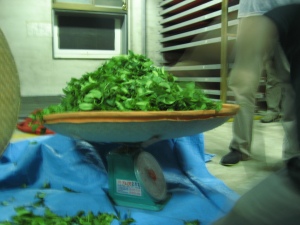 Most people were pretty tired and restless by this time, but tea never sleeps! Onto Oxidation. Once the leaves were emptied from the bamboo chamber, they were weighed and stacked densely on bamboo trays to promote the build up heat which greatly speeds up the oxidation process. If you imagine cutting into an apple, this is the affect of oxidation, synonymous with enzymatic browning. There are enzymes and organic compounds found in tea that in the presence of oxygen, react to generate this browning effect. This also required some hand tumbling (and more cupping…) before moving on to the next stage. The tea master decides when the tea leaves have oxidized enough to yield the desired outcome, in this case, a low oxidized, high mountain Oolong tea (Jade Oolong).
Most people were pretty tired and restless by this time, but tea never sleeps! Onto Oxidation. Once the leaves were emptied from the bamboo chamber, they were weighed and stacked densely on bamboo trays to promote the build up heat which greatly speeds up the oxidation process. If you imagine cutting into an apple, this is the affect of oxidation, synonymous with enzymatic browning. There are enzymes and organic compounds found in tea that in the presence of oxygen, react to generate this browning effect. This also required some hand tumbling (and more cupping…) before moving on to the next stage. The tea master decides when the tea leaves have oxidized enough to yield the desired outcome, in this case, a low oxidized, high mountain Oolong tea (Jade Oolong).
De-Enzyming, Panning, Rolling & Drying
Similar in concept to putting a stop to withering, so too we must put a stop to oxidation. In fact, this is possibly the most crucial of steps! The two main factors in defining a tea are the processing methods and the level of oxidation. You’ve either got a non-oxidized tea (green), partially oxidized tea (oolong), or fully oxidized tea (black). White and Yellow teas are a little more tricky to define, but still fall under the green or oolong category. Puer is also another animal all together, as it can be fully oxidized or not oxidized at all, and both go through a post-oxidation step called fermentation.



 Since the enzyme catalyzes oxidation in the tea leaf, one must rid of the enzymes to stop oxidation. This is done fairly easily by simply heating up the leaves beyond a certain degree, effectively killing the enzymes. There are various ways to do that, as there all with all of the steps I am describing, but in this case, the farmers at Dong Ding use a panning machine. This machine heats the leaves to a very high temperature for a short period of time (~5 minutes). The leaves are removed and quickly taken to a high-pressured rolling machine that spreads and coats the exterior of the leaf with its own juices. Again, this is carried out for a relatively short time before being thrown into another panning-like machine but without any heat to aerate and separate the leaves. Finally, the leaves are taken to a drying machine that slowly heats the leaves on a series of conveyor belts. The first drying takes a couple of hours whereas the second drying is much slower to really drop the moisture content below a certain percentage.
Since the enzyme catalyzes oxidation in the tea leaf, one must rid of the enzymes to stop oxidation. This is done fairly easily by simply heating up the leaves beyond a certain degree, effectively killing the enzymes. There are various ways to do that, as there all with all of the steps I am describing, but in this case, the farmers at Dong Ding use a panning machine. This machine heats the leaves to a very high temperature for a short period of time (~5 minutes). The leaves are removed and quickly taken to a high-pressured rolling machine that spreads and coats the exterior of the leaf with its own juices. Again, this is carried out for a relatively short time before being thrown into another panning-like machine but without any heat to aerate and separate the leaves. Finally, the leaves are taken to a drying machine that slowly heats the leaves on a series of conveyor belts. The first drying takes a couple of hours whereas the second drying is much slower to really drop the moisture content below a certain percentage.

Shaping
Now, while one might think the tea is finished after the second drying, this particular tea still has to go through 36 hydrolic-pressured rolling steps. It was nearly 2am by this time and we didn’t actually conduct these steps in the processing. It was carried out for us the following day:)




The tea is packed into a large cheese-cloth like bag, twisted, rolled, and separated, twisted and rolled, twisted and rolled. The frequency of such high pressured steps is what gives the tea its final balled-like shape so common to Oolong tea. It slowly transforms from the twisted style as seen out of the dryer, to the tightly packed condensed style you see below.

You may have guessed it, and yes, you were right, we had ONE FINAL CUPPING of the night. It was nearly 2am about now.

This time around, however, we were cupping our partially finished product versus the farmers partially finished product. You couldn’t see it in most of my pictures, but while we were processing our own personal batches of tea, the farmer and his workers were also processing LARGE volumes themselves. The main difference in our teas was the hand tumbling step, which simply couldn’t be replicated on such a large scale for the workers. Ostensibly, the hand-crafted effect yielded a superior tea, but it’s all subjective I suppose! It’s funny; this post took almost as long as the tea processing itself and I still haven’t sampled the finished product!!
I’ll mention once again that all of the detail in this post is ultimately subject to change and could never be exactly replicated. I only went in depth this much for my own personal fancy (and to help recollect the whole ordeal that seems like a blur from the past now)
And if you thought the events from this post were outrageous, just wait for tomorrow (day 4)…seriously.
Goodnight!

TLC
